Mergers and Acquisitions: A Case Study of Mitchells & Buttlers and JD
VerifiedAdded on 2023/01/07
|11
|3739
|68
Report
AI Summary
This report provides a comprehensive analysis of mergers and acquisitions (M&A), focusing on the acquisition of JD Wetherspoon plc by Mitchells & Buttlers plc. It begins by defining M&A, differentiating between acquisitions and mergers, and then explores the concepts of friendly and hostile takeovers, pre-bid and post-bid defenses, and their relevance to the case. The report then delves into the regulatory aspects, explaining the City Code and the role of the Competition and Markets Authority (CMA) in overseeing mergers. Furthermore, it examines different types of divestments and their suitability for the acquisition. Finally, the report discusses the process of selecting a suitable group for the acquisition. The report concludes that, given the scenario, the takeover is friendly, and pre-bid defense mechanisms would have been more beneficial for the target entity. The report also emphasizes the importance of regulatory compliance to ensure fair treatment of shareholders and prevent anti-competitive practices.
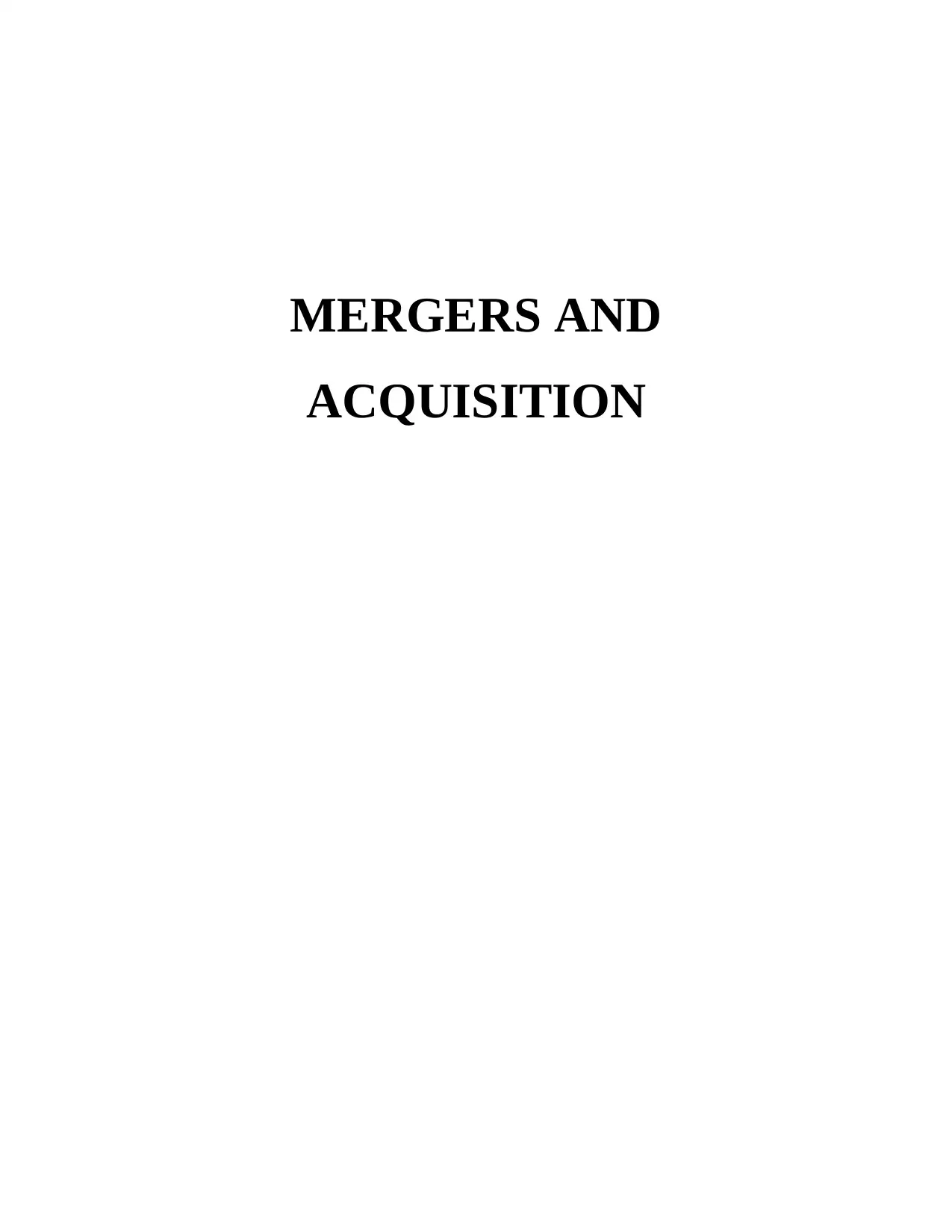
MERGERS AND
ACQUISITION
ACQUISITION
Paraphrase This Document
Need a fresh take? Get an instant paraphrase of this document with our AI Paraphraser
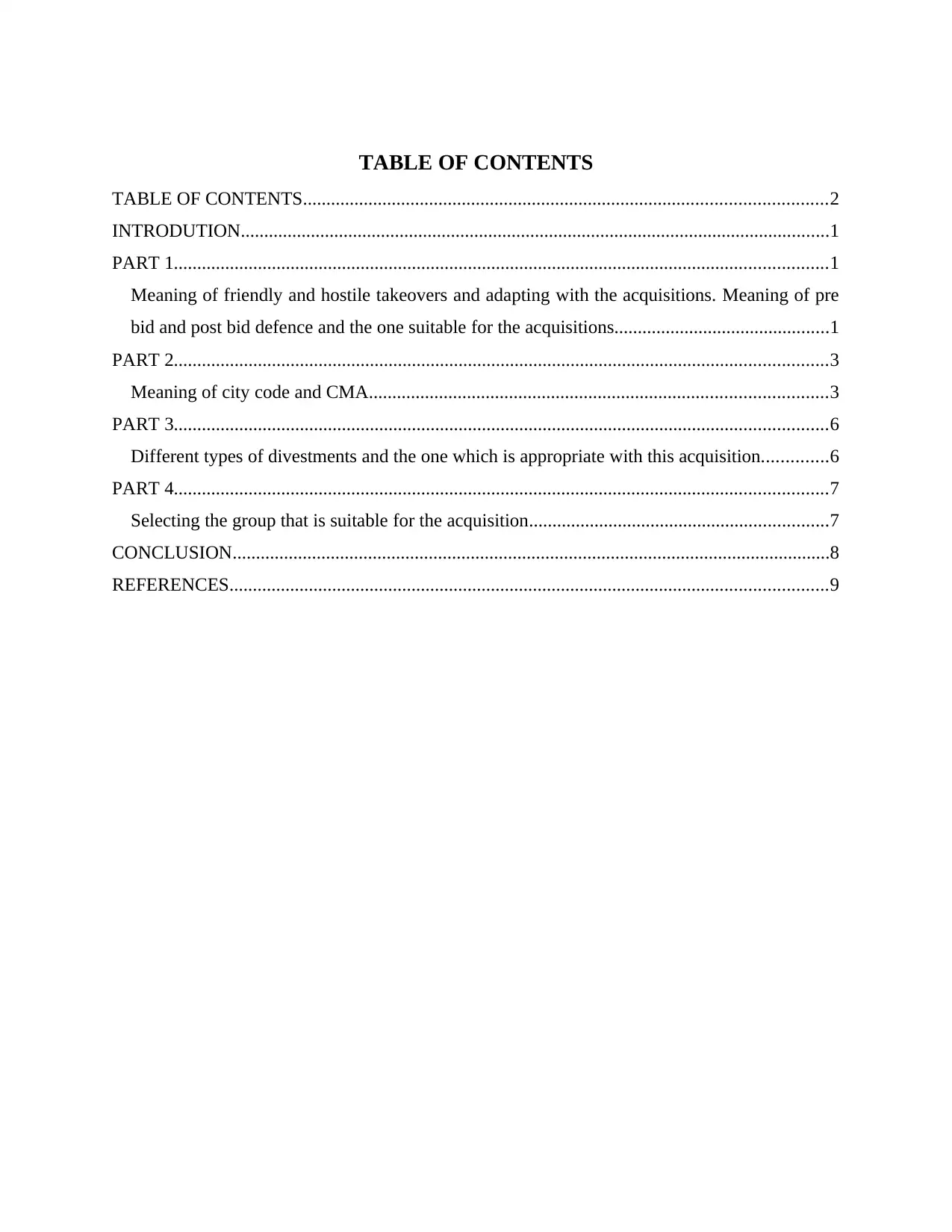
TABLE OF CONTENTS
TABLE OF CONTENTS................................................................................................................2
INTRODUTION..............................................................................................................................1
PART 1............................................................................................................................................1
Meaning of friendly and hostile takeovers and adapting with the acquisitions. Meaning of pre
bid and post bid defence and the one suitable for the acquisitions..............................................1
PART 2............................................................................................................................................3
Meaning of city code and CMA..................................................................................................3
PART 3............................................................................................................................................6
Different types of divestments and the one which is appropriate with this acquisition..............6
PART 4............................................................................................................................................7
Selecting the group that is suitable for the acquisition................................................................7
CONCLUSION................................................................................................................................8
REFERENCES................................................................................................................................9
TABLE OF CONTENTS................................................................................................................2
INTRODUTION..............................................................................................................................1
PART 1............................................................................................................................................1
Meaning of friendly and hostile takeovers and adapting with the acquisitions. Meaning of pre
bid and post bid defence and the one suitable for the acquisitions..............................................1
PART 2............................................................................................................................................3
Meaning of city code and CMA..................................................................................................3
PART 3............................................................................................................................................6
Different types of divestments and the one which is appropriate with this acquisition..............6
PART 4............................................................................................................................................7
Selecting the group that is suitable for the acquisition................................................................7
CONCLUSION................................................................................................................................8
REFERENCES................................................................................................................................9
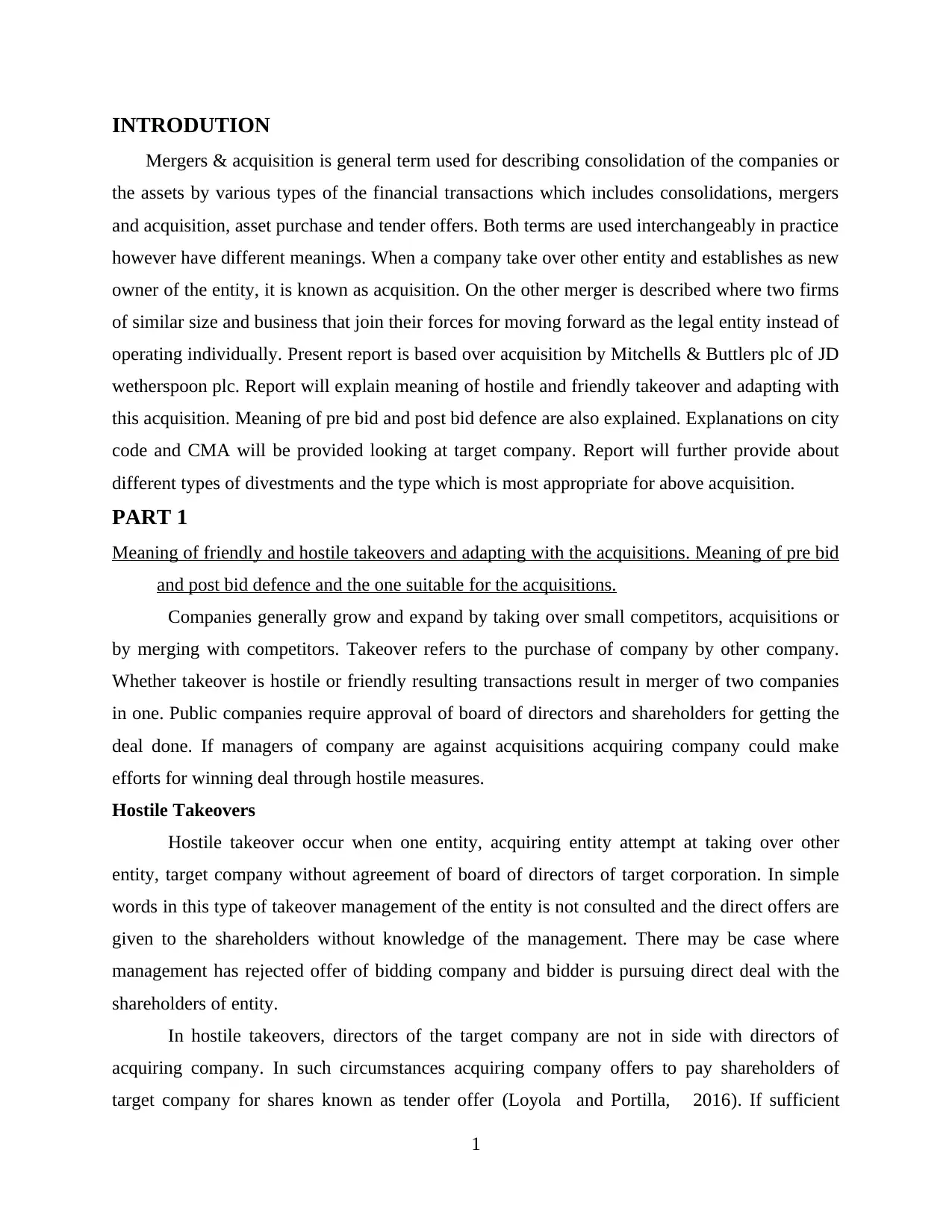
INTRODUTION
Mergers & acquisition is general term used for describing consolidation of the companies or
the assets by various types of the financial transactions which includes consolidations, mergers
and acquisition, asset purchase and tender offers. Both terms are used interchangeably in practice
however have different meanings. When a company take over other entity and establishes as new
owner of the entity, it is known as acquisition. On the other merger is described where two firms
of similar size and business that join their forces for moving forward as the legal entity instead of
operating individually. Present report is based over acquisition by Mitchells & Buttlers plc of JD
wetherspoon plc. Report will explain meaning of hostile and friendly takeover and adapting with
this acquisition. Meaning of pre bid and post bid defence are also explained. Explanations on city
code and CMA will be provided looking at target company. Report will further provide about
different types of divestments and the type which is most appropriate for above acquisition.
PART 1
Meaning of friendly and hostile takeovers and adapting with the acquisitions. Meaning of pre bid
and post bid defence and the one suitable for the acquisitions.
Companies generally grow and expand by taking over small competitors, acquisitions or
by merging with competitors. Takeover refers to the purchase of company by other company.
Whether takeover is hostile or friendly resulting transactions result in merger of two companies
in one. Public companies require approval of board of directors and shareholders for getting the
deal done. If managers of company are against acquisitions acquiring company could make
efforts for winning deal through hostile measures.
Hostile Takeovers
Hostile takeover occur when one entity, acquiring entity attempt at taking over other
entity, target company without agreement of board of directors of target corporation. In simple
words in this type of takeover management of the entity is not consulted and the direct offers are
given to the shareholders without knowledge of the management. There may be case where
management has rejected offer of bidding company and bidder is pursuing direct deal with the
shareholders of entity.
In hostile takeovers, directors of the target company are not in side with directors of
acquiring company. In such circumstances acquiring company offers to pay shareholders of
target company for shares known as tender offer (Loyola and Portilla, 2016). If sufficient
1
Mergers & acquisition is general term used for describing consolidation of the companies or
the assets by various types of the financial transactions which includes consolidations, mergers
and acquisition, asset purchase and tender offers. Both terms are used interchangeably in practice
however have different meanings. When a company take over other entity and establishes as new
owner of the entity, it is known as acquisition. On the other merger is described where two firms
of similar size and business that join their forces for moving forward as the legal entity instead of
operating individually. Present report is based over acquisition by Mitchells & Buttlers plc of JD
wetherspoon plc. Report will explain meaning of hostile and friendly takeover and adapting with
this acquisition. Meaning of pre bid and post bid defence are also explained. Explanations on city
code and CMA will be provided looking at target company. Report will further provide about
different types of divestments and the type which is most appropriate for above acquisition.
PART 1
Meaning of friendly and hostile takeovers and adapting with the acquisitions. Meaning of pre bid
and post bid defence and the one suitable for the acquisitions.
Companies generally grow and expand by taking over small competitors, acquisitions or
by merging with competitors. Takeover refers to the purchase of company by other company.
Whether takeover is hostile or friendly resulting transactions result in merger of two companies
in one. Public companies require approval of board of directors and shareholders for getting the
deal done. If managers of company are against acquisitions acquiring company could make
efforts for winning deal through hostile measures.
Hostile Takeovers
Hostile takeover occur when one entity, acquiring entity attempt at taking over other
entity, target company without agreement of board of directors of target corporation. In simple
words in this type of takeover management of the entity is not consulted and the direct offers are
given to the shareholders without knowledge of the management. There may be case where
management has rejected offer of bidding company and bidder is pursuing direct deal with the
shareholders of entity.
In hostile takeovers, directors of the target company are not in side with directors of
acquiring company. In such circumstances acquiring company offers to pay shareholders of
target company for shares known as tender offer (Loyola and Portilla, 2016). If sufficient
1
⊘ This is a preview!⊘
Do you want full access?
Subscribe today to unlock all pages.

Trusted by 1+ million students worldwide
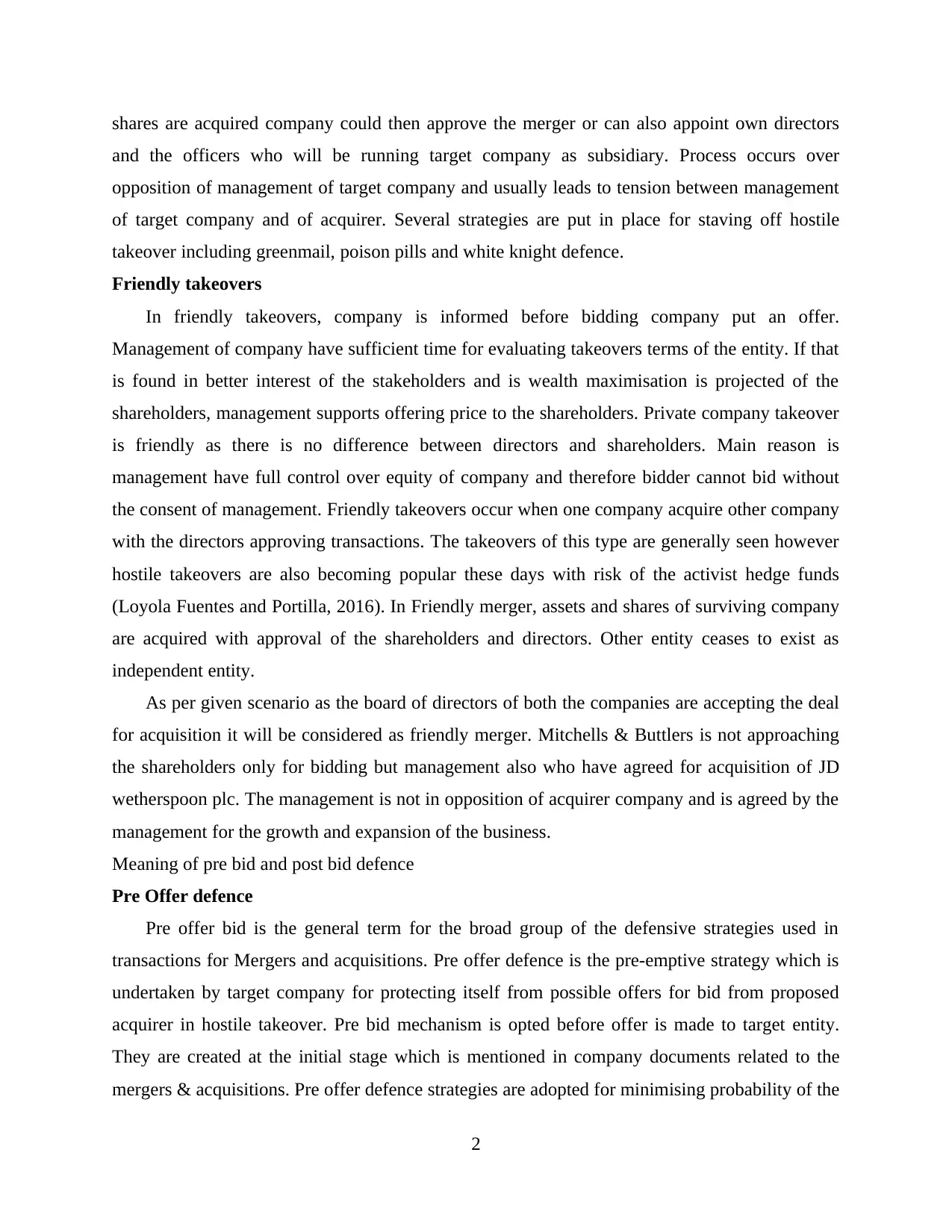
shares are acquired company could then approve the merger or can also appoint own directors
and the officers who will be running target company as subsidiary. Process occurs over
opposition of management of target company and usually leads to tension between management
of target company and of acquirer. Several strategies are put in place for staving off hostile
takeover including greenmail, poison pills and white knight defence.
Friendly takeovers
In friendly takeovers, company is informed before bidding company put an offer.
Management of company have sufficient time for evaluating takeovers terms of the entity. If that
is found in better interest of the stakeholders and is wealth maximisation is projected of the
shareholders, management supports offering price to the shareholders. Private company takeover
is friendly as there is no difference between directors and shareholders. Main reason is
management have full control over equity of company and therefore bidder cannot bid without
the consent of management. Friendly takeovers occur when one company acquire other company
with the directors approving transactions. The takeovers of this type are generally seen however
hostile takeovers are also becoming popular these days with risk of the activist hedge funds
(Loyola Fuentes and Portilla, 2016). In Friendly merger, assets and shares of surviving company
are acquired with approval of the shareholders and directors. Other entity ceases to exist as
independent entity.
As per given scenario as the board of directors of both the companies are accepting the deal
for acquisition it will be considered as friendly merger. Mitchells & Buttlers is not approaching
the shareholders only for bidding but management also who have agreed for acquisition of JD
wetherspoon plc. The management is not in opposition of acquirer company and is agreed by the
management for the growth and expansion of the business.
Meaning of pre bid and post bid defence
Pre Offer defence
Pre offer bid is the general term for the broad group of the defensive strategies used in
transactions for Mergers and acquisitions. Pre offer defence is the pre-emptive strategy which is
undertaken by target company for protecting itself from possible offers for bid from proposed
acquirer in hostile takeover. Pre bid mechanism is opted before offer is made to target entity.
They are created at the initial stage which is mentioned in company documents related to the
mergers & acquisitions. Pre offer defence strategies are adopted for minimising probability of the
2
and the officers who will be running target company as subsidiary. Process occurs over
opposition of management of target company and usually leads to tension between management
of target company and of acquirer. Several strategies are put in place for staving off hostile
takeover including greenmail, poison pills and white knight defence.
Friendly takeovers
In friendly takeovers, company is informed before bidding company put an offer.
Management of company have sufficient time for evaluating takeovers terms of the entity. If that
is found in better interest of the stakeholders and is wealth maximisation is projected of the
shareholders, management supports offering price to the shareholders. Private company takeover
is friendly as there is no difference between directors and shareholders. Main reason is
management have full control over equity of company and therefore bidder cannot bid without
the consent of management. Friendly takeovers occur when one company acquire other company
with the directors approving transactions. The takeovers of this type are generally seen however
hostile takeovers are also becoming popular these days with risk of the activist hedge funds
(Loyola Fuentes and Portilla, 2016). In Friendly merger, assets and shares of surviving company
are acquired with approval of the shareholders and directors. Other entity ceases to exist as
independent entity.
As per given scenario as the board of directors of both the companies are accepting the deal
for acquisition it will be considered as friendly merger. Mitchells & Buttlers is not approaching
the shareholders only for bidding but management also who have agreed for acquisition of JD
wetherspoon plc. The management is not in opposition of acquirer company and is agreed by the
management for the growth and expansion of the business.
Meaning of pre bid and post bid defence
Pre Offer defence
Pre offer bid is the general term for the broad group of the defensive strategies used in
transactions for Mergers and acquisitions. Pre offer defence is the pre-emptive strategy which is
undertaken by target company for protecting itself from possible offers for bid from proposed
acquirer in hostile takeover. Pre bid mechanism is opted before offer is made to target entity.
They are created at the initial stage which is mentioned in company documents related to the
mergers & acquisitions. Pre offer defence strategies are adopted for minimising probability of the
2
Paraphrase This Document
Need a fresh take? Get an instant paraphrase of this document with our AI Paraphraser
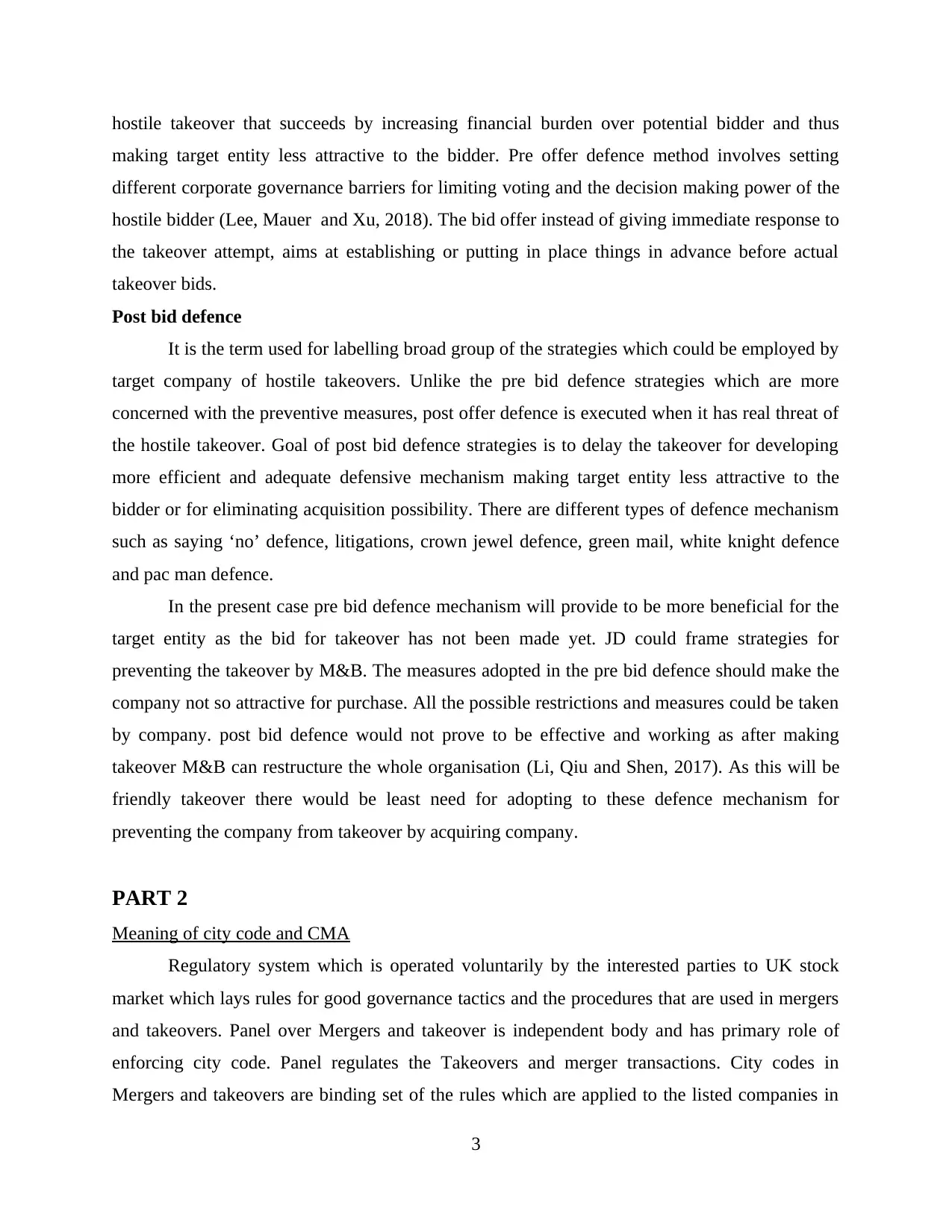
hostile takeover that succeeds by increasing financial burden over potential bidder and thus
making target entity less attractive to the bidder. Pre offer defence method involves setting
different corporate governance barriers for limiting voting and the decision making power of the
hostile bidder (Lee, Mauer and Xu, 2018). The bid offer instead of giving immediate response to
the takeover attempt, aims at establishing or putting in place things in advance before actual
takeover bids.
Post bid defence
It is the term used for labelling broad group of the strategies which could be employed by
target company of hostile takeovers. Unlike the pre bid defence strategies which are more
concerned with the preventive measures, post offer defence is executed when it has real threat of
the hostile takeover. Goal of post bid defence strategies is to delay the takeover for developing
more efficient and adequate defensive mechanism making target entity less attractive to the
bidder or for eliminating acquisition possibility. There are different types of defence mechanism
such as saying ‘no’ defence, litigations, crown jewel defence, green mail, white knight defence
and pac man defence.
In the present case pre bid defence mechanism will provide to be more beneficial for the
target entity as the bid for takeover has not been made yet. JD could frame strategies for
preventing the takeover by M&B. The measures adopted in the pre bid defence should make the
company not so attractive for purchase. All the possible restrictions and measures could be taken
by company. post bid defence would not prove to be effective and working as after making
takeover M&B can restructure the whole organisation (Li, Qiu and Shen, 2017). As this will be
friendly takeover there would be least need for adopting to these defence mechanism for
preventing the company from takeover by acquiring company.
PART 2
Meaning of city code and CMA
Regulatory system which is operated voluntarily by the interested parties to UK stock
market which lays rules for good governance tactics and the procedures that are used in mergers
and takeovers. Panel over Mergers and takeover is independent body and has primary role of
enforcing city code. Panel regulates the Takeovers and merger transactions. City codes in
Mergers and takeovers are binding set of the rules which are applied to the listed companies in
3
making target entity less attractive to the bidder. Pre offer defence method involves setting
different corporate governance barriers for limiting voting and the decision making power of the
hostile bidder (Lee, Mauer and Xu, 2018). The bid offer instead of giving immediate response to
the takeover attempt, aims at establishing or putting in place things in advance before actual
takeover bids.
Post bid defence
It is the term used for labelling broad group of the strategies which could be employed by
target company of hostile takeovers. Unlike the pre bid defence strategies which are more
concerned with the preventive measures, post offer defence is executed when it has real threat of
the hostile takeover. Goal of post bid defence strategies is to delay the takeover for developing
more efficient and adequate defensive mechanism making target entity less attractive to the
bidder or for eliminating acquisition possibility. There are different types of defence mechanism
such as saying ‘no’ defence, litigations, crown jewel defence, green mail, white knight defence
and pac man defence.
In the present case pre bid defence mechanism will provide to be more beneficial for the
target entity as the bid for takeover has not been made yet. JD could frame strategies for
preventing the takeover by M&B. The measures adopted in the pre bid defence should make the
company not so attractive for purchase. All the possible restrictions and measures could be taken
by company. post bid defence would not prove to be effective and working as after making
takeover M&B can restructure the whole organisation (Li, Qiu and Shen, 2017). As this will be
friendly takeover there would be least need for adopting to these defence mechanism for
preventing the company from takeover by acquiring company.
PART 2
Meaning of city code and CMA
Regulatory system which is operated voluntarily by the interested parties to UK stock
market which lays rules for good governance tactics and the procedures that are used in mergers
and takeovers. Panel over Mergers and takeover is independent body and has primary role of
enforcing city code. Panel regulates the Takeovers and merger transactions. City codes in
Mergers and takeovers are binding set of the rules which are applied to the listed companies in
3
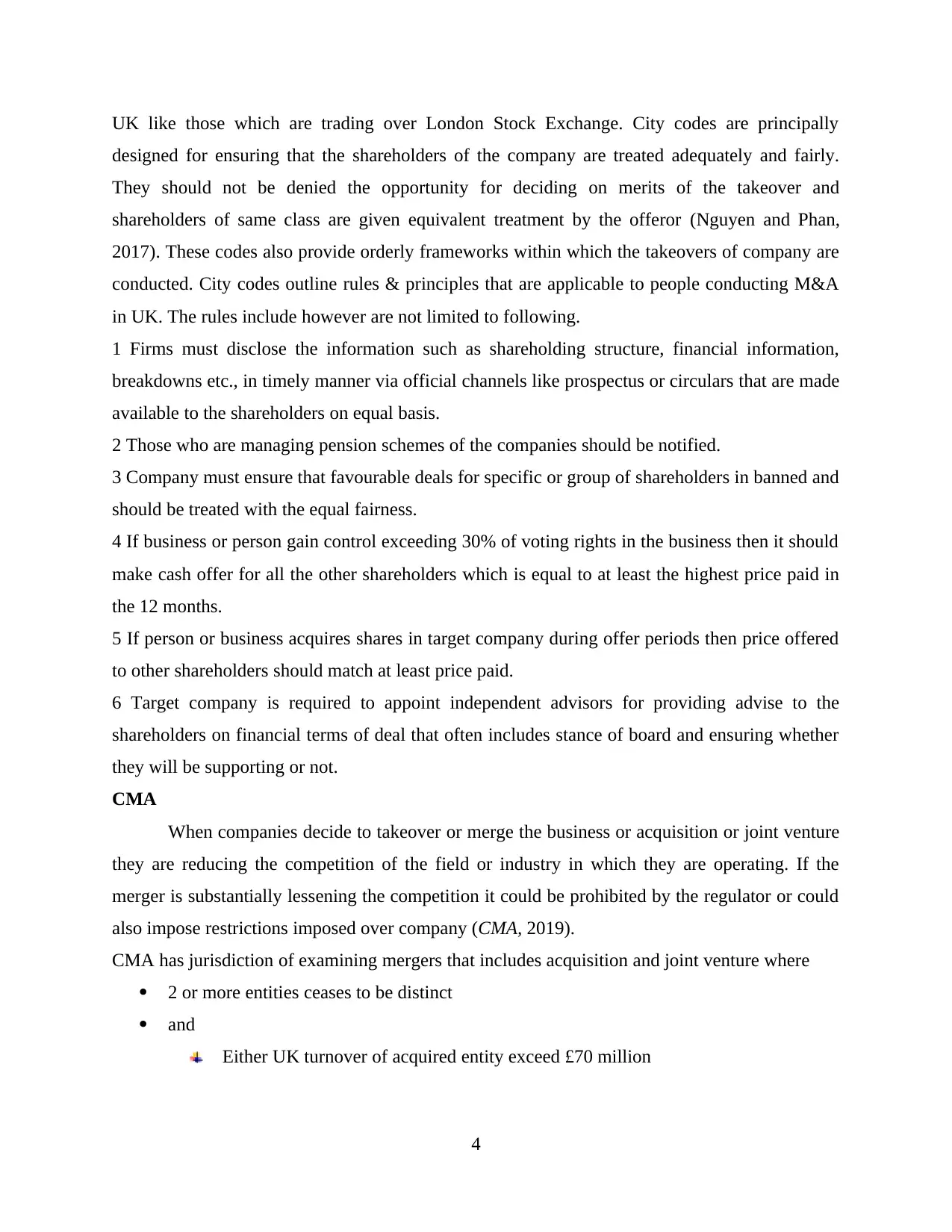
UK like those which are trading over London Stock Exchange. City codes are principally
designed for ensuring that the shareholders of the company are treated adequately and fairly.
They should not be denied the opportunity for deciding on merits of the takeover and
shareholders of same class are given equivalent treatment by the offeror (Nguyen and Phan,
2017). These codes also provide orderly frameworks within which the takeovers of company are
conducted. City codes outline rules & principles that are applicable to people conducting M&A
in UK. The rules include however are not limited to following.
1 Firms must disclose the information such as shareholding structure, financial information,
breakdowns etc., in timely manner via official channels like prospectus or circulars that are made
available to the shareholders on equal basis.
2 Those who are managing pension schemes of the companies should be notified.
3 Company must ensure that favourable deals for specific or group of shareholders in banned and
should be treated with the equal fairness.
4 If business or person gain control exceeding 30% of voting rights in the business then it should
make cash offer for all the other shareholders which is equal to at least the highest price paid in
the 12 months.
5 If person or business acquires shares in target company during offer periods then price offered
to other shareholders should match at least price paid.
6 Target company is required to appoint independent advisors for providing advise to the
shareholders on financial terms of deal that often includes stance of board and ensuring whether
they will be supporting or not.
CMA
When companies decide to takeover or merge the business or acquisition or joint venture
they are reducing the competition of the field or industry in which they are operating. If the
merger is substantially lessening the competition it could be prohibited by the regulator or could
also impose restrictions imposed over company (CMA, 2019).
CMA has jurisdiction of examining mergers that includes acquisition and joint venture where
2 or more entities ceases to be distinct
and
Either UK turnover of acquired entity exceed £70 million
4
designed for ensuring that the shareholders of the company are treated adequately and fairly.
They should not be denied the opportunity for deciding on merits of the takeover and
shareholders of same class are given equivalent treatment by the offeror (Nguyen and Phan,
2017). These codes also provide orderly frameworks within which the takeovers of company are
conducted. City codes outline rules & principles that are applicable to people conducting M&A
in UK. The rules include however are not limited to following.
1 Firms must disclose the information such as shareholding structure, financial information,
breakdowns etc., in timely manner via official channels like prospectus or circulars that are made
available to the shareholders on equal basis.
2 Those who are managing pension schemes of the companies should be notified.
3 Company must ensure that favourable deals for specific or group of shareholders in banned and
should be treated with the equal fairness.
4 If business or person gain control exceeding 30% of voting rights in the business then it should
make cash offer for all the other shareholders which is equal to at least the highest price paid in
the 12 months.
5 If person or business acquires shares in target company during offer periods then price offered
to other shareholders should match at least price paid.
6 Target company is required to appoint independent advisors for providing advise to the
shareholders on financial terms of deal that often includes stance of board and ensuring whether
they will be supporting or not.
CMA
When companies decide to takeover or merge the business or acquisition or joint venture
they are reducing the competition of the field or industry in which they are operating. If the
merger is substantially lessening the competition it could be prohibited by the regulator or could
also impose restrictions imposed over company (CMA, 2019).
CMA has jurisdiction of examining mergers that includes acquisition and joint venture where
2 or more entities ceases to be distinct
and
Either UK turnover of acquired entity exceed £70 million
4
⊘ This is a preview!⊘
Do you want full access?
Subscribe today to unlock all pages.

Trusted by 1+ million students worldwide
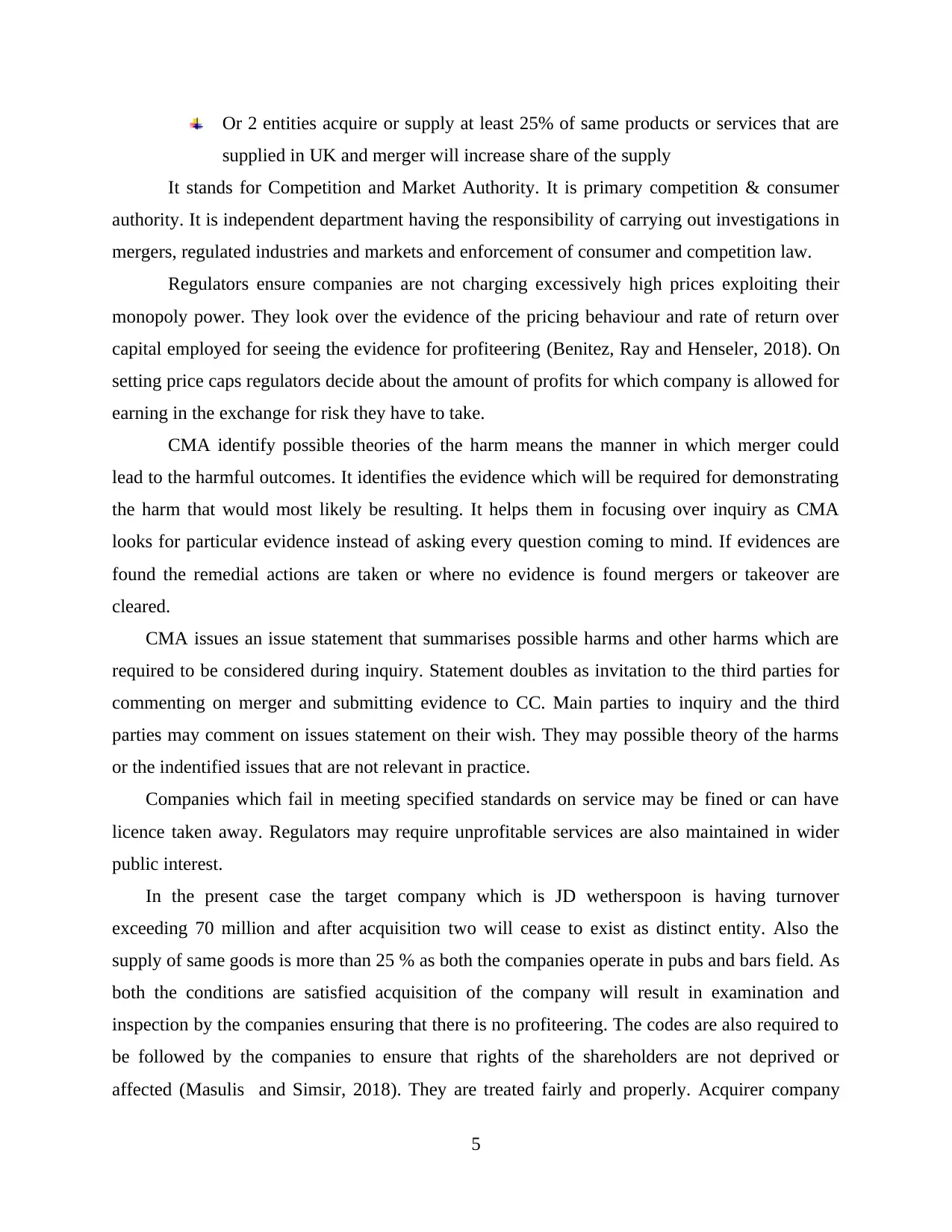
Or 2 entities acquire or supply at least 25% of same products or services that are
supplied in UK and merger will increase share of the supply
It stands for Competition and Market Authority. It is primary competition & consumer
authority. It is independent department having the responsibility of carrying out investigations in
mergers, regulated industries and markets and enforcement of consumer and competition law.
Regulators ensure companies are not charging excessively high prices exploiting their
monopoly power. They look over the evidence of the pricing behaviour and rate of return over
capital employed for seeing the evidence for profiteering (Benitez, Ray and Henseler, 2018). On
setting price caps regulators decide about the amount of profits for which company is allowed for
earning in the exchange for risk they have to take.
CMA identify possible theories of the harm means the manner in which merger could
lead to the harmful outcomes. It identifies the evidence which will be required for demonstrating
the harm that would most likely be resulting. It helps them in focusing over inquiry as CMA
looks for particular evidence instead of asking every question coming to mind. If evidences are
found the remedial actions are taken or where no evidence is found mergers or takeover are
cleared.
CMA issues an issue statement that summarises possible harms and other harms which are
required to be considered during inquiry. Statement doubles as invitation to the third parties for
commenting on merger and submitting evidence to CC. Main parties to inquiry and the third
parties may comment on issues statement on their wish. They may possible theory of the harms
or the indentified issues that are not relevant in practice.
Companies which fail in meeting specified standards on service may be fined or can have
licence taken away. Regulators may require unprofitable services are also maintained in wider
public interest.
In the present case the target company which is JD wetherspoon is having turnover
exceeding 70 million and after acquisition two will cease to exist as distinct entity. Also the
supply of same goods is more than 25 % as both the companies operate in pubs and bars field. As
both the conditions are satisfied acquisition of the company will result in examination and
inspection by the companies ensuring that there is no profiteering. The codes are also required to
be followed by the companies to ensure that rights of the shareholders are not deprived or
affected (Masulis and Simsir, 2018). They are treated fairly and properly. Acquirer company
5
supplied in UK and merger will increase share of the supply
It stands for Competition and Market Authority. It is primary competition & consumer
authority. It is independent department having the responsibility of carrying out investigations in
mergers, regulated industries and markets and enforcement of consumer and competition law.
Regulators ensure companies are not charging excessively high prices exploiting their
monopoly power. They look over the evidence of the pricing behaviour and rate of return over
capital employed for seeing the evidence for profiteering (Benitez, Ray and Henseler, 2018). On
setting price caps regulators decide about the amount of profits for which company is allowed for
earning in the exchange for risk they have to take.
CMA identify possible theories of the harm means the manner in which merger could
lead to the harmful outcomes. It identifies the evidence which will be required for demonstrating
the harm that would most likely be resulting. It helps them in focusing over inquiry as CMA
looks for particular evidence instead of asking every question coming to mind. If evidences are
found the remedial actions are taken or where no evidence is found mergers or takeover are
cleared.
CMA issues an issue statement that summarises possible harms and other harms which are
required to be considered during inquiry. Statement doubles as invitation to the third parties for
commenting on merger and submitting evidence to CC. Main parties to inquiry and the third
parties may comment on issues statement on their wish. They may possible theory of the harms
or the indentified issues that are not relevant in practice.
Companies which fail in meeting specified standards on service may be fined or can have
licence taken away. Regulators may require unprofitable services are also maintained in wider
public interest.
In the present case the target company which is JD wetherspoon is having turnover
exceeding 70 million and after acquisition two will cease to exist as distinct entity. Also the
supply of same goods is more than 25 % as both the companies operate in pubs and bars field. As
both the conditions are satisfied acquisition of the company will result in examination and
inspection by the companies ensuring that there is no profiteering. The codes are also required to
be followed by the companies to ensure that rights of the shareholders are not deprived or
affected (Masulis and Simsir, 2018). They are treated fairly and properly. Acquirer company
5
Paraphrase This Document
Need a fresh take? Get an instant paraphrase of this document with our AI Paraphraser
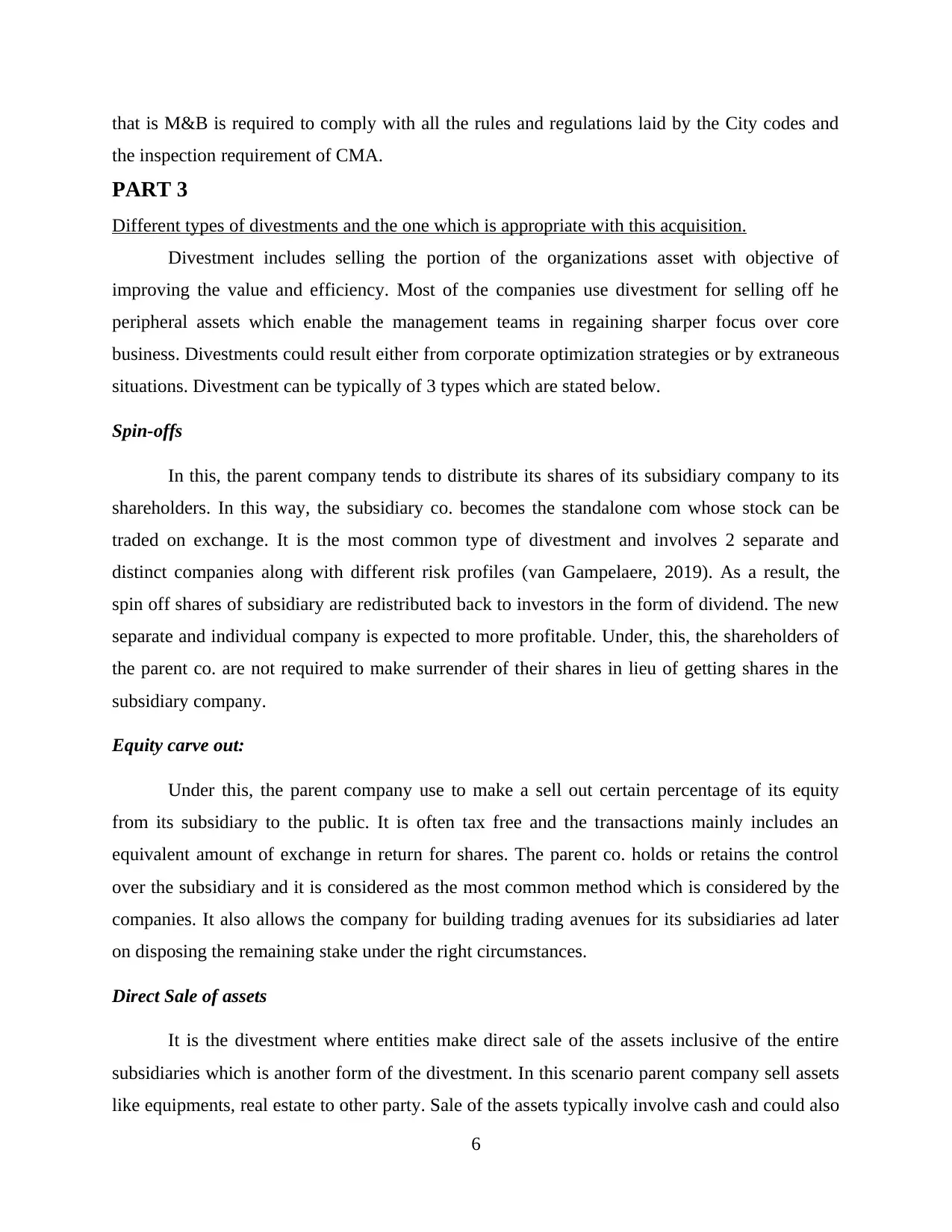
that is M&B is required to comply with all the rules and regulations laid by the City codes and
the inspection requirement of CMA.
PART 3
Different types of divestments and the one which is appropriate with this acquisition.
Divestment includes selling the portion of the organizations asset with objective of
improving the value and efficiency. Most of the companies use divestment for selling off he
peripheral assets which enable the management teams in regaining sharper focus over core
business. Divestments could result either from corporate optimization strategies or by extraneous
situations. Divestment can be typically of 3 types which are stated below.
Spin-offs
In this, the parent company tends to distribute its shares of its subsidiary company to its
shareholders. In this way, the subsidiary co. becomes the standalone com whose stock can be
traded on exchange. It is the most common type of divestment and involves 2 separate and
distinct companies along with different risk profiles (van Gampelaere, 2019). As a result, the
spin off shares of subsidiary are redistributed back to investors in the form of dividend. The new
separate and individual company is expected to more profitable. Under, this, the shareholders of
the parent co. are not required to make surrender of their shares in lieu of getting shares in the
subsidiary company.
Equity carve out:
Under this, the parent company use to make a sell out certain percentage of its equity
from its subsidiary to the public. It is often tax free and the transactions mainly includes an
equivalent amount of exchange in return for shares. The parent co. holds or retains the control
over the subsidiary and it is considered as the most common method which is considered by the
companies. It also allows the company for building trading avenues for its subsidiaries ad later
on disposing the remaining stake under the right circumstances.
Direct Sale of assets
It is the divestment where entities make direct sale of the assets inclusive of the entire
subsidiaries which is another form of the divestment. In this scenario parent company sell assets
like equipments, real estate to other party. Sale of the assets typically involve cash and could also
6
the inspection requirement of CMA.
PART 3
Different types of divestments and the one which is appropriate with this acquisition.
Divestment includes selling the portion of the organizations asset with objective of
improving the value and efficiency. Most of the companies use divestment for selling off he
peripheral assets which enable the management teams in regaining sharper focus over core
business. Divestments could result either from corporate optimization strategies or by extraneous
situations. Divestment can be typically of 3 types which are stated below.
Spin-offs
In this, the parent company tends to distribute its shares of its subsidiary company to its
shareholders. In this way, the subsidiary co. becomes the standalone com whose stock can be
traded on exchange. It is the most common type of divestment and involves 2 separate and
distinct companies along with different risk profiles (van Gampelaere, 2019). As a result, the
spin off shares of subsidiary are redistributed back to investors in the form of dividend. The new
separate and individual company is expected to more profitable. Under, this, the shareholders of
the parent co. are not required to make surrender of their shares in lieu of getting shares in the
subsidiary company.
Equity carve out:
Under this, the parent company use to make a sell out certain percentage of its equity
from its subsidiary to the public. It is often tax free and the transactions mainly includes an
equivalent amount of exchange in return for shares. The parent co. holds or retains the control
over the subsidiary and it is considered as the most common method which is considered by the
companies. It also allows the company for building trading avenues for its subsidiaries ad later
on disposing the remaining stake under the right circumstances.
Direct Sale of assets
It is the divestment where entities make direct sale of the assets inclusive of the entire
subsidiaries which is another form of the divestment. In this scenario parent company sell assets
like equipments, real estate to other party. Sale of the assets typically involve cash and could also
6
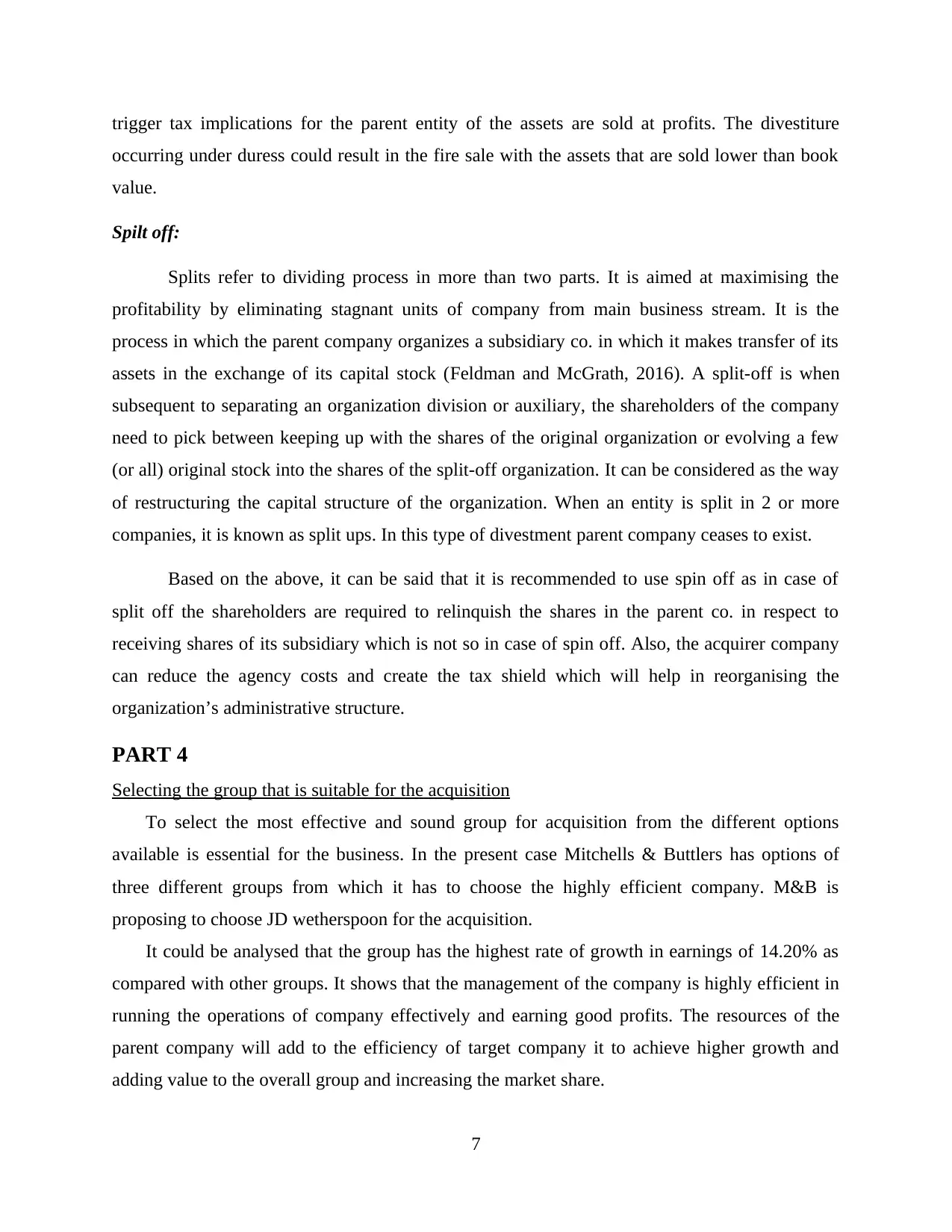
trigger tax implications for the parent entity of the assets are sold at profits. The divestiture
occurring under duress could result in the fire sale with the assets that are sold lower than book
value.
Spilt off:
Splits refer to dividing process in more than two parts. It is aimed at maximising the
profitability by eliminating stagnant units of company from main business stream. It is the
process in which the parent company organizes a subsidiary co. in which it makes transfer of its
assets in the exchange of its capital stock (Feldman and McGrath, 2016). A split-off is when
subsequent to separating an organization division or auxiliary, the shareholders of the company
need to pick between keeping up with the shares of the original organization or evolving a few
(or all) original stock into the shares of the split-off organization. It can be considered as the way
of restructuring the capital structure of the organization. When an entity is split in 2 or more
companies, it is known as split ups. In this type of divestment parent company ceases to exist.
Based on the above, it can be said that it is recommended to use spin off as in case of
split off the shareholders are required to relinquish the shares in the parent co. in respect to
receiving shares of its subsidiary which is not so in case of spin off. Also, the acquirer company
can reduce the agency costs and create the tax shield which will help in reorganising the
organization’s administrative structure.
PART 4
Selecting the group that is suitable for the acquisition
To select the most effective and sound group for acquisition from the different options
available is essential for the business. In the present case Mitchells & Buttlers has options of
three different groups from which it has to choose the highly efficient company. M&B is
proposing to choose JD wetherspoon for the acquisition.
It could be analysed that the group has the highest rate of growth in earnings of 14.20% as
compared with other groups. It shows that the management of the company is highly efficient in
running the operations of company effectively and earning good profits. The resources of the
parent company will add to the efficiency of target company it to achieve higher growth and
adding value to the overall group and increasing the market share.
7
occurring under duress could result in the fire sale with the assets that are sold lower than book
value.
Spilt off:
Splits refer to dividing process in more than two parts. It is aimed at maximising the
profitability by eliminating stagnant units of company from main business stream. It is the
process in which the parent company organizes a subsidiary co. in which it makes transfer of its
assets in the exchange of its capital stock (Feldman and McGrath, 2016). A split-off is when
subsequent to separating an organization division or auxiliary, the shareholders of the company
need to pick between keeping up with the shares of the original organization or evolving a few
(or all) original stock into the shares of the split-off organization. It can be considered as the way
of restructuring the capital structure of the organization. When an entity is split in 2 or more
companies, it is known as split ups. In this type of divestment parent company ceases to exist.
Based on the above, it can be said that it is recommended to use spin off as in case of
split off the shareholders are required to relinquish the shares in the parent co. in respect to
receiving shares of its subsidiary which is not so in case of spin off. Also, the acquirer company
can reduce the agency costs and create the tax shield which will help in reorganising the
organization’s administrative structure.
PART 4
Selecting the group that is suitable for the acquisition
To select the most effective and sound group for acquisition from the different options
available is essential for the business. In the present case Mitchells & Buttlers has options of
three different groups from which it has to choose the highly efficient company. M&B is
proposing to choose JD wetherspoon for the acquisition.
It could be analysed that the group has the highest rate of growth in earnings of 14.20% as
compared with other groups. It shows that the management of the company is highly efficient in
running the operations of company effectively and earning good profits. The resources of the
parent company will add to the efficiency of target company it to achieve higher growth and
adding value to the overall group and increasing the market share.
7
⊘ This is a preview!⊘
Do you want full access?
Subscribe today to unlock all pages.

Trusted by 1+ million students worldwide
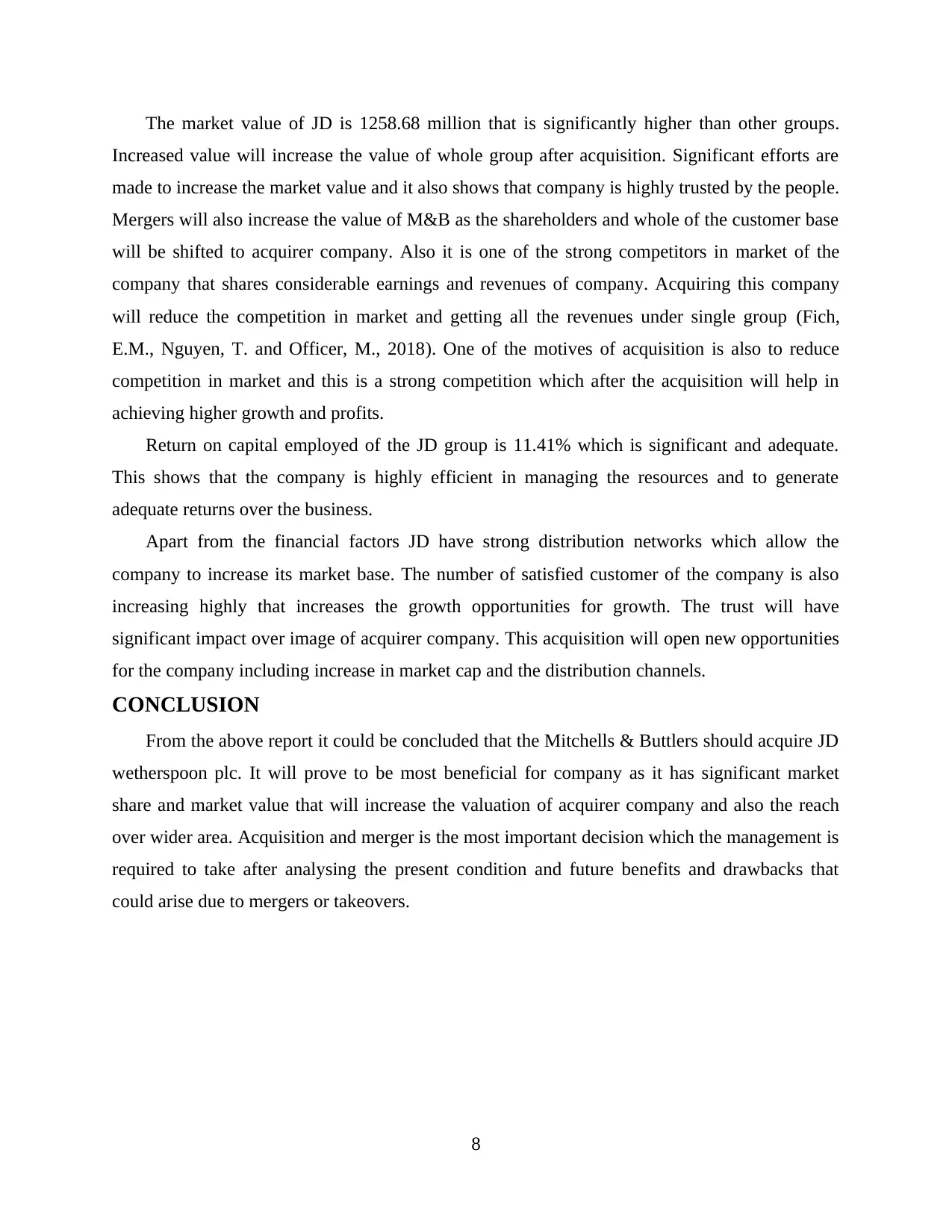
The market value of JD is 1258.68 million that is significantly higher than other groups.
Increased value will increase the value of whole group after acquisition. Significant efforts are
made to increase the market value and it also shows that company is highly trusted by the people.
Mergers will also increase the value of M&B as the shareholders and whole of the customer base
will be shifted to acquirer company. Also it is one of the strong competitors in market of the
company that shares considerable earnings and revenues of company. Acquiring this company
will reduce the competition in market and getting all the revenues under single group (Fich,
E.M., Nguyen, T. and Officer, M., 2018). One of the motives of acquisition is also to reduce
competition in market and this is a strong competition which after the acquisition will help in
achieving higher growth and profits.
Return on capital employed of the JD group is 11.41% which is significant and adequate.
This shows that the company is highly efficient in managing the resources and to generate
adequate returns over the business.
Apart from the financial factors JD have strong distribution networks which allow the
company to increase its market base. The number of satisfied customer of the company is also
increasing highly that increases the growth opportunities for growth. The trust will have
significant impact over image of acquirer company. This acquisition will open new opportunities
for the company including increase in market cap and the distribution channels.
CONCLUSION
From the above report it could be concluded that the Mitchells & Buttlers should acquire JD
wetherspoon plc. It will prove to be most beneficial for company as it has significant market
share and market value that will increase the valuation of acquirer company and also the reach
over wider area. Acquisition and merger is the most important decision which the management is
required to take after analysing the present condition and future benefits and drawbacks that
could arise due to mergers or takeovers.
8
Increased value will increase the value of whole group after acquisition. Significant efforts are
made to increase the market value and it also shows that company is highly trusted by the people.
Mergers will also increase the value of M&B as the shareholders and whole of the customer base
will be shifted to acquirer company. Also it is one of the strong competitors in market of the
company that shares considerable earnings and revenues of company. Acquiring this company
will reduce the competition in market and getting all the revenues under single group (Fich,
E.M., Nguyen, T. and Officer, M., 2018). One of the motives of acquisition is also to reduce
competition in market and this is a strong competition which after the acquisition will help in
achieving higher growth and profits.
Return on capital employed of the JD group is 11.41% which is significant and adequate.
This shows that the company is highly efficient in managing the resources and to generate
adequate returns over the business.
Apart from the financial factors JD have strong distribution networks which allow the
company to increase its market base. The number of satisfied customer of the company is also
increasing highly that increases the growth opportunities for growth. The trust will have
significant impact over image of acquirer company. This acquisition will open new opportunities
for the company including increase in market cap and the distribution channels.
CONCLUSION
From the above report it could be concluded that the Mitchells & Buttlers should acquire JD
wetherspoon plc. It will prove to be most beneficial for company as it has significant market
share and market value that will increase the valuation of acquirer company and also the reach
over wider area. Acquisition and merger is the most important decision which the management is
required to take after analysing the present condition and future benefits and drawbacks that
could arise due to mergers or takeovers.
8
Paraphrase This Document
Need a fresh take? Get an instant paraphrase of this document with our AI Paraphraser
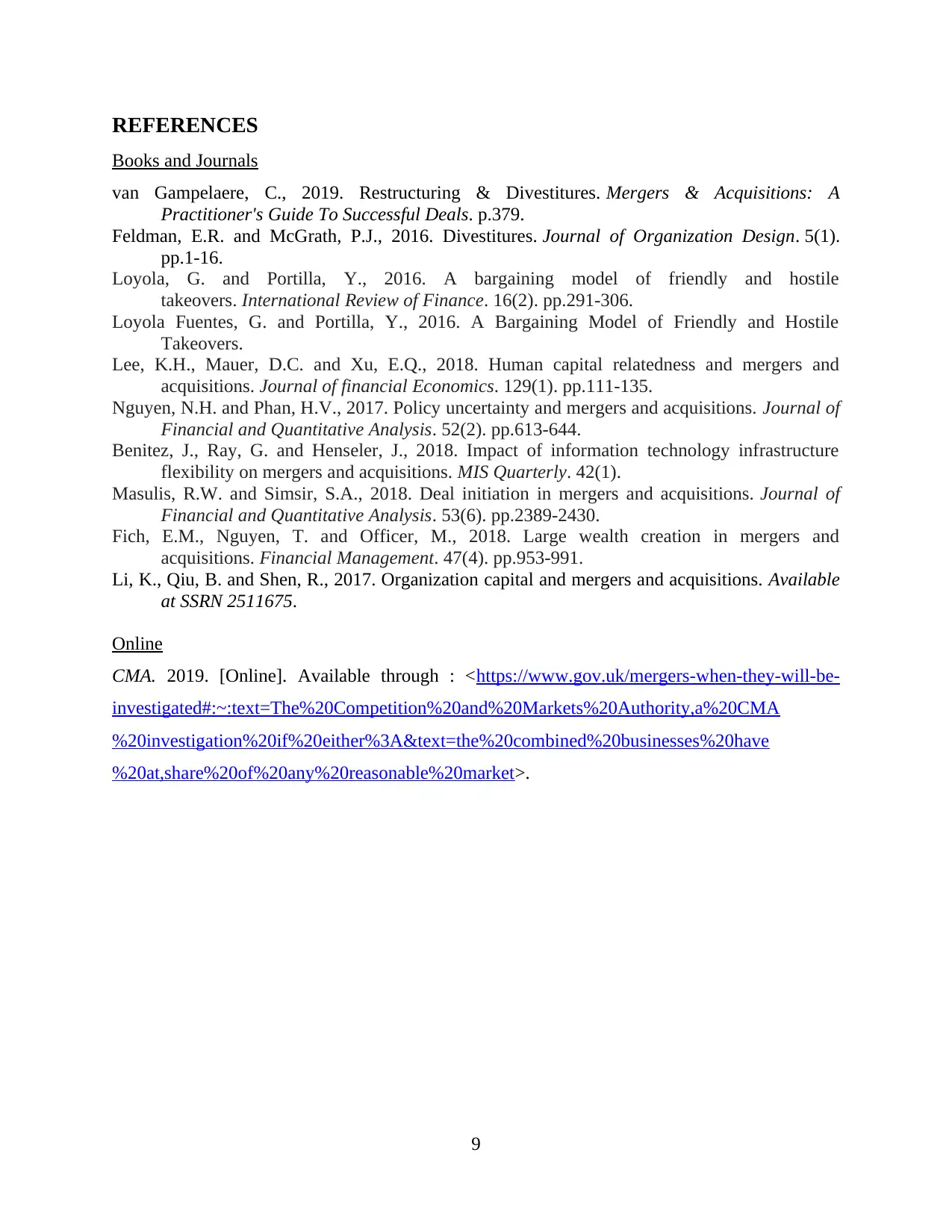
REFERENCES
Books and Journals
van Gampelaere, C., 2019. Restructuring & Divestitures. Mergers & Acquisitions: A
Practitioner's Guide To Successful Deals. p.379.
Feldman, E.R. and McGrath, P.J., 2016. Divestitures. Journal of Organization Design. 5(1).
pp.1-16.
Loyola, G. and Portilla, Y., 2016. A bargaining model of friendly and hostile
takeovers. International Review of Finance. 16(2). pp.291-306.
Loyola Fuentes, G. and Portilla, Y., 2016. A Bargaining Model of Friendly and Hostile
Takeovers.
Lee, K.H., Mauer, D.C. and Xu, E.Q., 2018. Human capital relatedness and mergers and
acquisitions. Journal of financial Economics. 129(1). pp.111-135.
Nguyen, N.H. and Phan, H.V., 2017. Policy uncertainty and mergers and acquisitions. Journal of
Financial and Quantitative Analysis. 52(2). pp.613-644.
Benitez, J., Ray, G. and Henseler, J., 2018. Impact of information technology infrastructure
flexibility on mergers and acquisitions. MIS Quarterly. 42(1).
Masulis, R.W. and Simsir, S.A., 2018. Deal initiation in mergers and acquisitions. Journal of
Financial and Quantitative Analysis. 53(6). pp.2389-2430.
Fich, E.M., Nguyen, T. and Officer, M., 2018. Large wealth creation in mergers and
acquisitions. Financial Management. 47(4). pp.953-991.
Li, K., Qiu, B. and Shen, R., 2017. Organization capital and mergers and acquisitions. Available
at SSRN 2511675.
Online
CMA. 2019. [Online]. Available through : <https://www.gov.uk/mergers-when-they-will-be-
investigated#:~:text=The%20Competition%20and%20Markets%20Authority,a%20CMA
%20investigation%20if%20either%3A&text=the%20combined%20businesses%20have
%20at,share%20of%20any%20reasonable%20market>.
9
Books and Journals
van Gampelaere, C., 2019. Restructuring & Divestitures. Mergers & Acquisitions: A
Practitioner's Guide To Successful Deals. p.379.
Feldman, E.R. and McGrath, P.J., 2016. Divestitures. Journal of Organization Design. 5(1).
pp.1-16.
Loyola, G. and Portilla, Y., 2016. A bargaining model of friendly and hostile
takeovers. International Review of Finance. 16(2). pp.291-306.
Loyola Fuentes, G. and Portilla, Y., 2016. A Bargaining Model of Friendly and Hostile
Takeovers.
Lee, K.H., Mauer, D.C. and Xu, E.Q., 2018. Human capital relatedness and mergers and
acquisitions. Journal of financial Economics. 129(1). pp.111-135.
Nguyen, N.H. and Phan, H.V., 2017. Policy uncertainty and mergers and acquisitions. Journal of
Financial and Quantitative Analysis. 52(2). pp.613-644.
Benitez, J., Ray, G. and Henseler, J., 2018. Impact of information technology infrastructure
flexibility on mergers and acquisitions. MIS Quarterly. 42(1).
Masulis, R.W. and Simsir, S.A., 2018. Deal initiation in mergers and acquisitions. Journal of
Financial and Quantitative Analysis. 53(6). pp.2389-2430.
Fich, E.M., Nguyen, T. and Officer, M., 2018. Large wealth creation in mergers and
acquisitions. Financial Management. 47(4). pp.953-991.
Li, K., Qiu, B. and Shen, R., 2017. Organization capital and mergers and acquisitions. Available
at SSRN 2511675.
Online
CMA. 2019. [Online]. Available through : <https://www.gov.uk/mergers-when-they-will-be-
investigated#:~:text=The%20Competition%20and%20Markets%20Authority,a%20CMA
%20investigation%20if%20either%3A&text=the%20combined%20businesses%20have
%20at,share%20of%20any%20reasonable%20market>.
9
1 out of 11
Your All-in-One AI-Powered Toolkit for Academic Success.
+13062052269
info@desklib.com
Available 24*7 on WhatsApp / Email
![[object Object]](/_next/static/media/star-bottom.7253800d.svg)
Unlock your academic potential
Copyright © 2020–2025 A2Z Services. All Rights Reserved. Developed and managed by ZUCOL.


